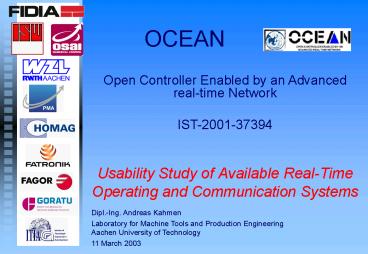Usability Study of Available RealTime Operating and Communication Systems - PowerPoint PPT Presentation
1 / 13
Title:
Usability Study of Available RealTime Operating and Communication Systems
Description:
Laboratory for Machine Tools and Production Engineering. Aachen ... CIAO (TAO for C ; open source) CIAO will be first implementation available with QoS ... – PowerPoint PPT presentation
Number of Views:61
Avg rating:3.0/5.0
Title: Usability Study of Available RealTime Operating and Communication Systems
1
Usability Study of Available Real-Time Operating
and Communication Systems
Dipl.-Ing. Andreas Kahmen Laboratory for Machine
Tools and Production EngineeringAachen
University of Technology 11 March 2003
2
Contents of presentation
- Analysis of available Linux implementations
- Comparison of Linux real-time extensions
- Investigation of Linux networking and device
support - Comparison of Linux with standard operating
systems - Analysis of available CORBA implementations
- Comparison of CORBA implementations
- Interoperability between different ORBs
- Investigation of CORBA Component Model
- Time measurements for TAO
3
Comparison of Linux implementations
- Suitable Linux real-time extensions are RTLinux
and RTAI - The comparison resulted that RTAI provides better
real-time support than RTLinux - soft real-time in user space along with hard
real-time in kernel space - excellent performance in terms of low jitter and
low latency - better C support and more complete feature set
- availability of LXRT which allows user space
applications in kernel space - RTAI has the better open source approach with
frequent feedback from developers
4
Linux Networking and Device Support
- Linux support of network devices
- Ethernet (10 Mbps, Fast and Gigabit Ethernet)
- FDDI (Fiber Distributed Data Interface, 100 Mbps)
- Wireless LAN (Local Area Network)
- ISDN (Integrated Services Digital Network)
- WAN (Wide Area Network)
- Linux networking protocol support
- TCP/IP (standard and version 6)
- Fieldbus protocols (e.g. CAN, Profibus, Interbus,
ControlNet, DeviceNet, AS-I, ...) - PPP (Point-to-Point), SLIP (Serial Line IP), PLIP
(Parallel Line IP)
5
Benefits of Linux
- Linux has been ported to various platforms
- High level development and supporting tools are
available - Full control over source code and operating
system functionality - Open to all standards
- No royalties
- High reliability
6
Comparison of Linux with standard OS
- Interrupt latency time and jitter are comparable
to standards real-time OS - The coupling of real-time part and non-real-time
part is realised like for commercial real-time
extensions - More real-time drivers are available open source
than for commercial solutions - Development tools for open source real-time
solutions are usually more powerful than
commercial ones - Linux with RTAI real-time extension is an
excellent operating system for an Open Source
control platform
7
Comparison of CORBA implementations (I)
- Research for 11 different ORBs applying the
following criteria - Open source availablity
- CORBA version implemented
- Real-time capability and implemented RT CORBA
features - Available language bindings
- Implemented CORBA services
- Supported multithreading concept
- Supported protocols
- Tested Linux and compiler support
8
Comparison of CORBA implementations (II)
- All ORBs except for JacORB and VisiBroker RT have
been ported and tested on Linux platforms - All ORBs except JacORB offer Language C
bindings - TAO and ROFES provide real-time capability
- Real-time versions of ORBExpress, eORB and
VisiBroker are available only in commercial
distributions - Basic Services (e.g. Naming, Event, Trading) are
provided by almost all ORBs - Biggest range of implemented CORBA services are
offered by TAO and ORBit
9
Interoperability between different ORBs
- ORB interoperability is covered by OMG
specifications since CORBA 2.0 - Interoperability is secured by General Inter-ORB
Protocol (GIOP) - Interoperable Object Reference (IOR) specifies
standardised object reference format - All ORBs of the research are implemented based on
CORBA 2.0 or higher (IIOP available) - Successful interoperability test have been
reported for TAO, MICO and JacORB - Projects for interoperability tests between
different ORBs - CORVAL2
- COST
10
Investigation of CORBA Component Model
- CCM defines features and services for
implementation, management, configuration and
deployment of components with commonly used CORBA
services - Application of CCM eases software reuse
- CCM provides Quality of Service (QoS)
capabilities - monitoring and control of components behaviour
- Current CCM implementations are among others
- OpenCCM (ORBacus and VisiBroker for Java open
source) - MicoCCM (MICO for C GPL/LGPL)
- K2 (TAO, ORBacus, ORBIX for C commercial)
- CIAO (TAO for C open source)
- CIAO will be first implementation available with
QoS RT-CCM
11
Time measurements for TAO
- Test environment
- Hardware Motorola PowerPC (MPC604)
333MHz - Operating System VxWorks 5.4.2 Tornado
2.0.2 - Compiler GCC Version cygnus-2.7.2
- ORB TAO 1.2a release of OCI
- Test conditions
- One server and one client
- methods provided by the server
- call_double_void( ) (return type double
marshalling) - call_double_long( long ) (return type double
parameter type long marshalling) - call_long_void( ) (return type long
marshalling) - call_double_sequence( sequenceltdoublegt )
- (parameter marshalling of a sequence
of doubles return type double)
12
Measurements for call_long_void()
- Server priority 6 Client priority
7 Measurements for round trip times
13
Conclusions for time measurements
- The round trip measurements reflect the minimum
time for method calls using TAO - Additional measurements with different
configurations will be done in the future - TAO fulfils the requirements for the real-time
communication within the DCRF

